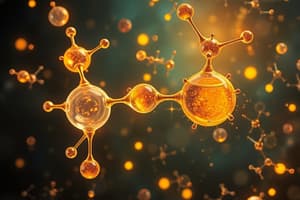Podcast
Questions and Answers
Which of the following reactions is typically involved in Electrophilic Aromatic Substitution (EAS)?
Which of the following reactions is typically involved in Electrophilic Aromatic Substitution (EAS)?
- Reduction with NaBH₄
- Nucleophilic Addition
- Halogenation with Cl₂ and AlCl₃ (correct)
- Oxidation with PCC
Tertiary alcohols undergo oxidation to form ketones.
Tertiary alcohols undergo oxidation to form ketones.
False (B)
What is the major product when a primary alcohol is oxidized using Jones reagent?
What is the major product when a primary alcohol is oxidized using Jones reagent?
Carboxylic acid
The mechanism that explains the reaction of aldehydes and ketones with nucleophiles is called _____.
The mechanism that explains the reaction of aldehydes and ketones with nucleophiles is called _____.
Match the following reactions with their corresponding categories:
Match the following reactions with their corresponding categories:
In the context of aromatic compounds, which substituent is considered deactivating?
In the context of aromatic compounds, which substituent is considered deactivating?
Enolates can be formed using strong bases such as LDA or NaH.
Enolates can be formed using strong bases such as LDA or NaH.
What is the role of AlCl₃ in Friedel-Crafts reactions?
What is the role of AlCl₃ in Friedel-Crafts reactions?
Which reaction converts carboxylic acids into hydrocarbons?
Which reaction converts carboxylic acids into hydrocarbons?
Transesterification involves the exchange of alkyl groups in alcohols.
Transesterification involves the exchange of alkyl groups in alcohols.
What are the products formed when esters are reduced using LiAlH₄?
What are the products formed when esters are reduced using LiAlH₄?
In the Diels-Alder reaction, a diene reacts with a __________ to produce a cyclohexene derivative.
In the Diels-Alder reaction, a diene reacts with a __________ to produce a cyclohexene derivative.
Match the following types of reactions with their descriptions:
Match the following types of reactions with their descriptions:
Which reaction is a form of nucleophilic acyl substitution?
Which reaction is a form of nucleophilic acyl substitution?
Proton NMR provides information about the chemical shifts of carbon atoms in a molecule.
Proton NMR provides information about the chemical shifts of carbon atoms in a molecule.
What is the main outcome of the Claisen condensation reaction?
What is the main outcome of the Claisen condensation reaction?
What is the product when alkyl bromide (R-Br) is treated with magnesium in dry ether?
What is the product when alkyl bromide (R-Br) is treated with magnesium in dry ether?
The reaction of an alkyne with sodium amide (NaNH2) produces a carbanion.
The reaction of an alkyne with sodium amide (NaNH2) produces a carbanion.
What is the effect of H2 in the presence of Raney Ni on alkenes?
What is the effect of H2 in the presence of Raney Ni on alkenes?
When benzene is treated with sulfur trioxide and sulfuric acid, it undergoes _____ to form benzenesulfonic acid.
When benzene is treated with sulfur trioxide and sulfuric acid, it undergoes _____ to form benzenesulfonic acid.
Match the following reagents with their corresponding products:
Match the following reagents with their corresponding products:
Flashcards
Decarboxylation
Decarboxylation
A reaction where a carboxylic acid loses a carbon dioxide molecule to form a hydrocarbon. For example, beta-keto acids undergo decarboxylation.
Esterification
Esterification
A reaction where a carboxylic acid reacts with an alcohol to form an ester. The reaction is called Fischer esterification.
Nucleophilic Acyl Substitution
Nucleophilic Acyl Substitution
A reaction where a nucleophile attacks the carbonyl carbon of an acid chloride or ester, replacing the leaving group.
Grignard Reaction
Grignard Reaction
Signup and view all the flashcards
Aldol Condensation
Aldol Condensation
Signup and view all the flashcards
Diels-Alder Reaction
Diels-Alder Reaction
Signup and view all the flashcards
Radical Substitution
Radical Substitution
Signup and view all the flashcards
Proton NMR (¹H NMR)
Proton NMR (¹H NMR)
Signup and view all the flashcards
Huckel's Rule
Huckel's Rule
Signup and view all the flashcards
Electrophilic Aromatic Substitution (EAS)
Electrophilic Aromatic Substitution (EAS)
Signup and view all the flashcards
Activating Substituents
Activating Substituents
Signup and view all the flashcards
Deactivating Substituents
Deactivating Substituents
Signup and view all the flashcards
Sn1 and Sn2 Reactions (Alcohols)
Sn1 and Sn2 Reactions (Alcohols)
Signup and view all the flashcards
Oxidation of Alcohols
Oxidation of Alcohols
Signup and view all the flashcards
Nucleophilic Addition (Aldehydes & Ketones)
Nucleophilic Addition (Aldehydes & Ketones)
Signup and view all the flashcards
Alkylation (General)
Alkylation (General)
Signup and view all the flashcards
Grignard Reagent
Grignard Reagent
Signup and view all the flashcards
Wittig Reaction
Wittig Reaction
Signup and view all the flashcards
Aldehyde Oxidation
Aldehyde Oxidation
Signup and view all the flashcards
Alkyne Addition
Alkyne Addition
Signup and view all the flashcards
Study Notes
Aromatic Compounds and Aromaticity
- Aromaticity follows Huckel's Rule (4n + 2 π-electrons).
- Aromatic systems exhibit resonance and delocalization.
- Electrophilic Aromatic Substitution (EAS) is a key reaction mechanism.
- Common EAS reactions include halogenation (Br2, FeBr3/Cl2, AlCl3), nitration (HNO3, H2SO4), and sulfonation (SO3, H2SO4).
Friedel-Crafts Alkylation
- Friedel-Crafts alkylation involves aromatic compounds reacting with alkyl halides in the presence of a Lewis acid catalyst (e.g. AlCl3).
- This reaction introduces an alkyl group onto the aromatic ring.
- The major product is typically formed through a stepwise mechanism, resulting in a substitution reaction.
Friedel-Crafts Acylation
- In Friedel-Crafts acylation, an acyl group is introduced onto an aromatic ring.
- Acyl chlorides react with aromatic compounds in the presence of a Lewis acid catalyst(e.g. aluminum chloride).
- This results in the production of ketones.
Activating vs. Deactivating Substituents
- Substituents affect the reactivity of aromatic compounds.
- Some groups, like -OH, -NH2, activate the ring toward further substitution reactions, directing the incoming group to ortho or para positions.
- Other groups, like -NO2, -CN, deactivate the ring and lead to substitution at the meta position.
Reactions of Alcohols and Phenols
- Alcohols undergo nucleophilic substitution (Sn1, Sn2) reactions.
- Different types of alcohols can be oxidized. Primary alcohols to aldehyde, secondary alcohols to ketone. Tertiary alcohols cannot undergo oxidation.
- Jones reagent (CrO3 in H2SO4/acetone) is an example of a strong oxidant used in oxidation reactions of alcohols.
- Phenols are stronger acids than alcohols. They also readily undergo electrophilic substitution reactions.
Carbonyl Chemistry
- Aldehydes and ketones undergo nucleophilic addition reactions with various nucleophiles. This reaction often involves a stepwise mechanism.
- NaBH4 and LiAlH4 are reagents for reducing aldehydes and ketones to alcohols.
- Aldehydes undergo oxidation to carboxylic acids.
- Aldol condensation and Cannizzaro reaction are specific reactions of aldehydes and ketones.
- Carboxylic acids participate in various reactions that include decarboxylation, reduction, and esterification.
Acid Chlorides, Esters, and Amides
- Acid chlorides, esters, and amides undergo nucleophilic acyl substitution reactions.
- Amides may undergo hydrolysis(conversion to carboxylic acids).
- Esters can be reduced using LiAlH4 to yield alcohols or aldehydes.
Synthesis and Retrosynthesis
- Retrosynthetic analysis involves breaking down a complex molecule into simpler, more readily accessible reactants.
- Functional group interconversions and disconnections are essential strategies.
- Grignard reactions, Aldol condensation, and Claisen condensation are key reactions for building carbon-carbon bonds.
Organometallic Chemistry
- Organolithium and Grignard reagents are examples of organometallic reagents that act as nucleophiles.
- These reagents participate in nucleophilic additions and substitutions to carbonyl compounds.
Radical Reactions
- Radical substitution and addition reactions often involve the presence of heat or light.
- Radical reactions can lead to the formation of polymers from alkenes.
Pericyclic Reactions
- Cycloadditions (e.g., Diels-Alder) and sigmatropic rearrangements are examples of pericyclic reactions.
- These reactions involve ring closures or openings typically involving conjugated systems.
- Reactions often proceed through thermal or photochemical pathways.
Spectroscopy and Structure Determination
- NMR spectroscopy (proton and carbon-13) provides information about chemical shifts and coupling constants.
- IR spectroscopy reveals functional groups based on absorption frequencies.
- Mass spectrometry provides fragmentation patterns, aiding in structural elucidation.
Studying That Suits You
Use AI to generate personalized quizzes and flashcards to suit your learning preferences.



